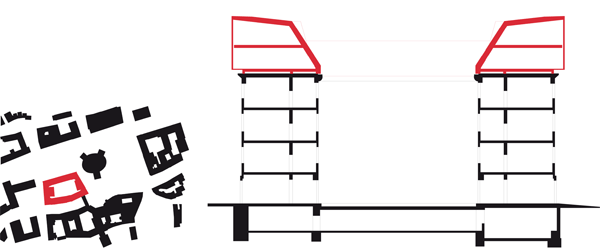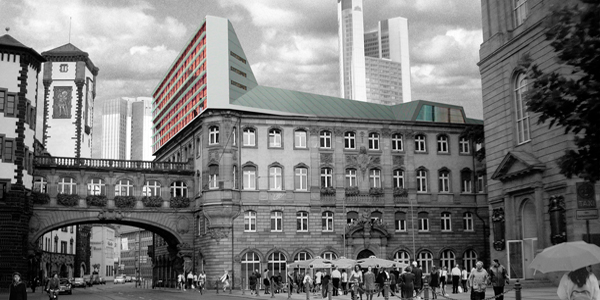
City Hall Silhouette – Die Neuinterpretation der lokalen Historie
Die Aufstockung des Frankfurter Rathauses hat die Form eines nach innen gewendeten Mansarddaches. Das ursprüngliche Dach aus der Vorkriegszeit hatte eine abschirmende Funktion. Das neue Dach hingegen ist nach außen gekehrt und auf die umgebende Stadt ausgerichtet. Die alten, engen und gewundenen Gassen Frankfurts leben nur noch fort in Form kontroverser Rekonstruktionen. Die heutige Stadt ist eines der internationalen Finanzzentren, mit ihren charakteristischen Hochhäusern und dem Luftfahrt Drehkreuz Europas ist sie ein Schaufenster zum Himmel.
Die Proportionen der doppelgeschossigen Rustica und der Piani Nobili des ursprünglichen Gebäudes werden mit einer verglasten vitrinenartigen Loggia neu ausgerichtet. Die streng gehaltene moderne Ergänzung zügelt damit die Ausschweifungen des Eklektizismus aus dem frühen 20. Jahrhundert. Die gerade Nordfassade verstärkt den Palazzo Eindruck, während die südlich gelegene Loggia den geschwungenen Verlauf der Straße dramatisiert. Eine Holzkonstruktion in Leichtbauweise bietet zudem ein weiteres ungewöhnliches Moment. Eine rote Wand trennt die Büros von der zur Straße gelegenen, verglasten Erschließungsbox und reflektiert zugleich den rötlichen Sandstein der Rustica.
Nachts verwandelt sich die Aufstockung in eine schwebende Lichtskulptur - zwischen ursprünglicher Fassade und Aufstockung informiert ein LED-Band über die historischen Daten dieses besonderen Ortes gegenüber der Paulskirche, wo 1848 das erste deutsche Parlament zusammentrat.
City Hall Silhouette – The reinterpretation of local history
The Frankfurt city hall extension takes the form of a new
inverted Mansard roof. The original pre-war roof had a shielding function, whereas the new roof faces outwards, addressing the surrounding city. Frankfurt's original narrow winding alleys now only survive in the form of controversial reconstructions in contrast to the contemporary city, which is one of international finance, high-rise buildings and Europe's central air traffic hub - it is a display window to the sky.
The proportions of the double-storey rustica and piani nobili of the original building have been rescripted with a new vitrine loggia. The strict modern extension curbs the excesses of early 20th century eclecticism. The straight north façade reinforces the palazzo image whereas the south loggia dramatises the curve of the street. A lightweight wooden construction allows for non-standard moments. A red wall separates the offices from the glazed circulation box and reflects the reddish sandstone rustica below.
At night the extension transforms into a hovering light box. Data relating to the historical significance of this particular place (the site is opposite the Paulskirche where the first German democratic parliament met in 1848) run as an LED strip between the existing façade and extension.



